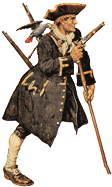 
The questions everyone asks
| ||||||||||||||||||||||||||||||||||||||||||||||||||||||||||||||||||||||||||||||||
| » see integrality of questions/answers (total: 126) » see list of questions |
Question of Alexandra (05.16.2023): Is maritime piracy increasing because of global warming and its effects on fish stocks?
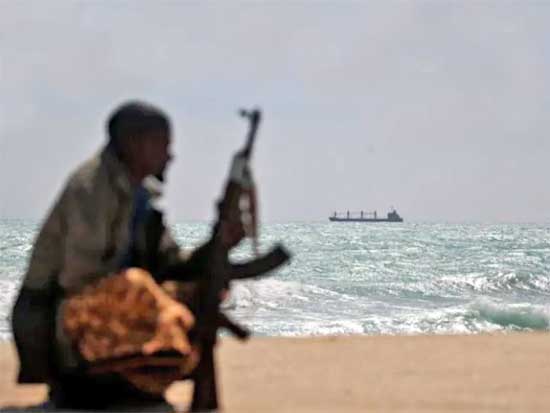 R:
R:
Indeed, the impact of warming seas on fish stocks is actually causing an increase in pirate attacks.
A study of piracy hotspots in East Africa and the South China Sea found that piracy increases when fish populations decrease and vice versa.
Sea piracy is linked to the impact of global warming
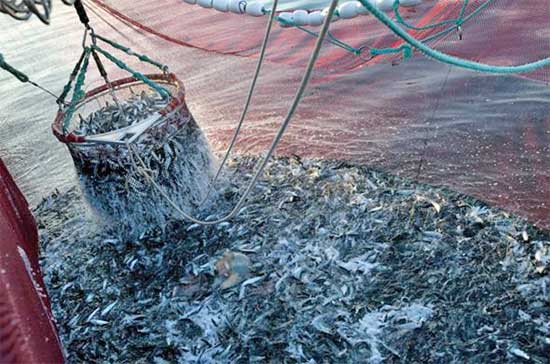
According to Gary LaFree*, professor of criminology and criminal justice, after testing the hypothesis of piracy increasing when fish production decreases and vice versa, the answer is yes. "We did a multivariate analysis to see if the underlying theory was statistically significant and it is.
The study looked at more than 2,000 attacks in East Africa and the South China Sea over the past 20 years, and found that piracy trends were linked to the impact of warming seas on fish stocks.
In East Africa, where fish populations are declining due to warming seas, piracy rates have increased. In contrast, rising sea temperatures have had the opposite effect in the South China Sea. There, fish populations have increased and piracy rates have decreased.
Indeed, when fish production increases, it can contribute to the economic stability of fishing communities. Increased fish stocks mean more resources available to fishers, which can reduce tensions and conflicts related to competition for limited resources. As a result, the incentives for piracy at sea may decrease, as fishers have access to enough fish to meet their needs.
The poorest fishermen engage in maritime piracy
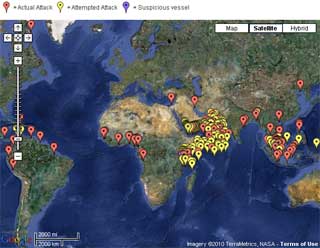
Fishermen, who are part of the poorest communities in the world, are targeted by criminal syndicates engaged in piracy. Thus, some fishermen fall into piracy, by necessity, depending on the evolution of fishing.
And this is not new, in the 17th century during the golden age of maritime piracy, unemployed sailors and fishermen too poor to live from fishing became pirates and went to sea to launch attacks to plunder commercial ships.
Today, it still works the same way, with the added factor of global warming..
Bo Jiang, an assistant professor at the University of Macau's Faculty of Social Sciences, said, "I grew up in Singapore, there are many fishermen in the nearby waters who are known as 'pirates-in-waiting.'".
The link between warming seas, fishing and pirate attacks is significant, even after taking into account other factors such as economic stress, political situation, armed conflict, private security guards on board ships and local political corruption. This study also raises questions about how to help fishermen.
Climate change will accelerate, inexorably leading to an increase in maritime piracy
Thus, according to the results of this study, as sea temperatures continue to rise for the foreseeable future, combating piracy in East Africa will become increasingly difficult.
Piracy costs the shipping industry $9 billion a year and is a major security threat. Approximately 90% of the world's trade is transported by sea.
Gary LaFree is a professor of criminology and criminal justice at the University of Maryland and one of the co-authors of the paper published in the American Meteorological Society journal, Weather, Climate, and Society (WCAS)
Bo Jiang is an assistant professor in the School of Social Sciences at the University of Macau and lead author of the study.
Question of Menelwen (04.14.2023): What techniques did pirates and privateers use to tattoo themselves? Were there colored pigments for tattooing or were they all tattooed with black ink? Also: were there people whose roles were attached. Thank you for your striking work!
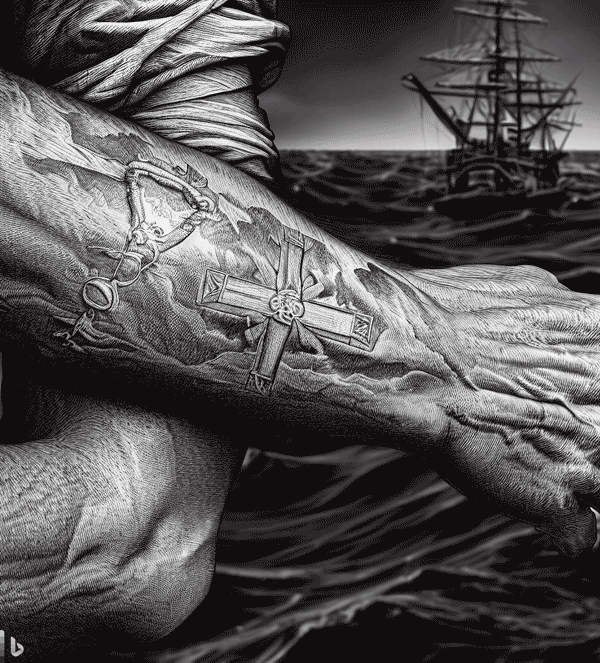 R:
R:
Some 17th century pirates were tattooed, although the tattooing techniques used at the time varied depending on where the tattoo was done and the pirate's culture of origin.
In general, tattooed pirates were mainly sailors and freebooters who had traveled to different parts of the world, which allowed them to acquire different tattoo traditions and cultural motifs.
So there were several techniques to tattoo themselves. One of the most common was to use bone or metal needles, often attached to a stick or rod, to pierce the skin and insert the ink. They could also use a needle used to stitch the sails of the ship. The ink used was usually made from natural substances such as charcoal or plant-based pigments.
The ink could also be finely ground gunpowder to create a permanent mark.
The finest tattoos, especially those of the greatest artists, are printed more deeply. They first make a rough drawing of the figure they want to draw with the brush and color; then they prick all around with a sharp thorn until blood gushes out; then they rub the place with their hands, dipped in the color they want to draw; and the image thus made is indelible.
As far as colors are concerned, pirates of the 17th century had access to pigments of different colors for their tattoos. However, it is important to note that black ink was the most common color for tattoos at the time.
There is no conclusive evidence of specialized tattoo artists among 17th century pirates. In general, pirates tattooed each other, often with the help of whoever had the most knowledge about tattooing. The designs used were often symbols of life at sea, such as anchors, dolphins, mermaids, ships, maps and compasses.
On the other hand, there is evidence of tattoos done by pirates. The buccaneer surgeon Lionel Wafer, writing in the 1680s, noted that "one of my companions once asked me to remove from his cheek one of these printed pictures, which was made by the negroes, his name was Bullman; which I could not do effectually, after much scarification and removal of a great deal of skin." (Lionel Wafer, in A New Voyage & Description of the Isthmus of America. Oxford: Hackluyt Society, 1934, page 83).
Indeed, Lionel Wafer was attempting to surgically remove a gunpowder spot, which was the common name for tattoos in English. The term came about as a result of the following process: drilling holes in the skin and rubbing finely ground gunpowder into them to create a permanent mark.
There is also evidence of some sailors tattooed in Virginia about 1720, with the letters S.P. on one hand and black spots on the other hand, as well as one arm with "our Savior on the Cross," and on the other arm "Adam and Eve," all supposedly done with gunpowder." (The American Mercury, March 17, 1720, #13.).
Question of Lucas (03.01.2023): How did the crew repair a cannonball hole in the hull of their boat? Did they do it during the fight? Thanks
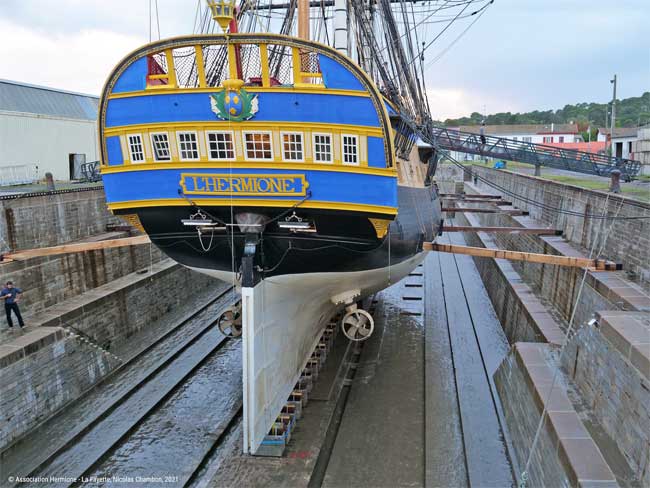 R:
There is a specific term for the repair operation in maritime language, "refit" (see definition below).
R:
There is a specific term for the repair operation in maritime language, "refit" (see definition below).In the 18th century, sailors had several methods of refitting their ships if they had been damaged by a cannonball. The repair process depended on the extent of the damage. The best method was to hull the ship (put the ship on its side/lay it down to expose the submerged part of the hull), but this was not always possible in the middle of a naval battle.
Here are the different steps to repair the ship:
- Assessing the damage: Sailors had to first assess the extent of the damage to determine the type and amount of material needed for the repair.
- Plugging Holes: If the cannonball had created a hole in the hull, sailors had to plug the hole to prevent water from rushing into the ship.
To do this, they often used wooden beams (bastaing), sails, tarpaulin, or sacks filled with straw to plug the holes.- With wooden beams, the sailors had to cut them to the appropriate size to cover the gap. They had to make sure they were wide enough to cover the damaged area and that they were securely fastened in place.
- With sails: Sailors had to cut pieces of sails to the size needed to cover the breach. They had to make sure the sail pieces were large enough to cover the damaged area.
- Equipping the ship to fight leaks: The sailors then had to set up pumps and buckets to remove the water that entered the ship through the holes.
- Make final repairs: Once the damage was under control, the sailors would make more permanent repairs by replacing damaged parts with new ones. They might also reinforce the hull with iron plates, ropes or tar-impregnated cloth to prevent further damage.
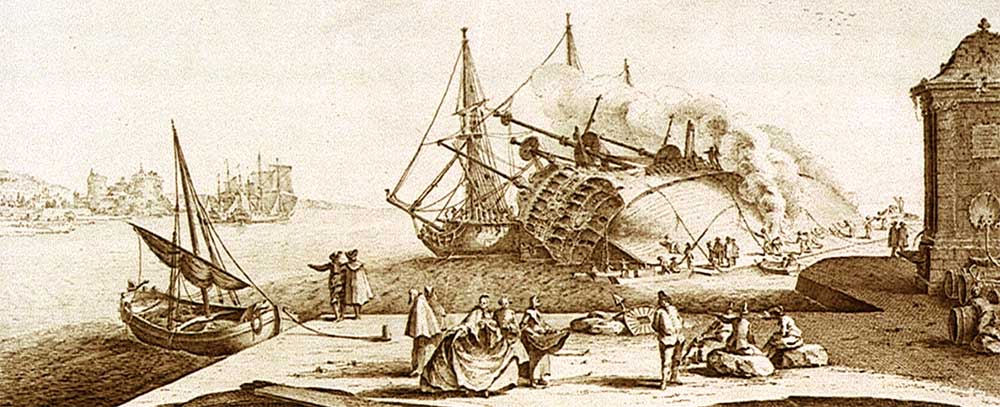
Of course, repair methods could vary depending on the nature of the damage and the experience and creativity of the sailors involved.
However, if the breach was below the waterline, which was rare because the sea dampened the impact of the cannonballs, it was very difficult to repair and the outcome could be fatal.
Definition of Refit: Repair more or less considerable that one makes, or with the hull of a vessel, or with its mast, or with its sails, etc. The refit of a vessel consists in the operation of putting new pieces of wood in the place of those which are rotten, or which can no longer fulfill their original purpose. - A ship in refit is one that is repaired, ship repairing; and to make this repair, is to give a refit.
Question of Swann (02.08.2023): Where did pirates repair their ships after being damaged by cannons?
How long did it take to repair a boat and how did they repair them?
If they were wanted, could they not land in any port? Thanks for this site !
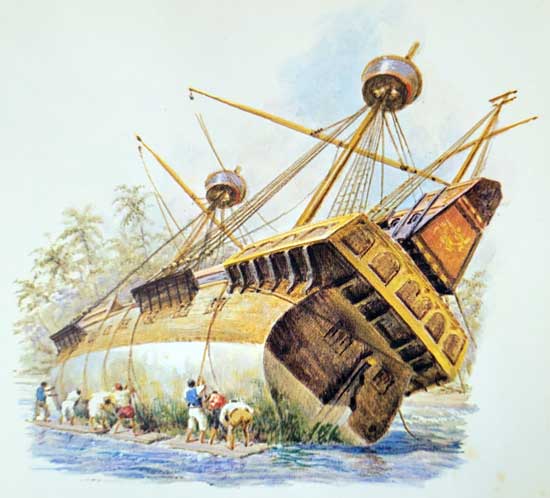
Repairing a badly damaged ship required putting it into a « hull »
After naval battles and collisions, ships were damaged and needed to be repaired.If the repairs to be done were basic, they could be done on the water, preferably in calm water. Close to a friendly port was much better because they could run out of things they didn't have in their ship, such as hemp to caulk, wood to repair the railings or the hull.
When the ship was too slow, it had to be refitted. The refit operation consisted in cleaning and repairing the submerged part of the hull, often covered with shells, algae and worms that were eating away at the wood and slowing down the ship.
The hull is the set of structures that form the hull and is located below the waterline.
Where did pirates repair their ships?
Pirates would repair their ships in ports off the usual trade routes, such as hidden bays or isolated islands.They could also find refuge in friendly ports, such as pirate-controlled ports or ports established by tolerant nations.
The islands in question were isolated such as the Caribbean islands, the West African coast, the island of Madagascar, the Sunda Islands, among others. Some of these islands were known for their safe shelter and developed infrastructure for naval repairs.
How is a ship careened?
Pirates repaired their ships using carpentry skills, using tools and materials available on the ship or purchased from islands and ports.They could also call on local experts to help with more complex repairs. The goal was to keep the ship in good working order so that they could continue to sail and carry out their illegal activities.
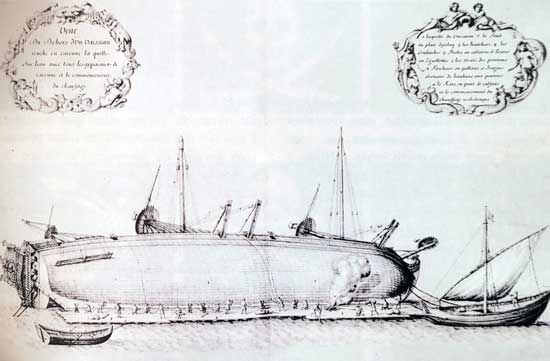
Question of Théo and Sarah (01.31.2023): How far away is the horizon when looking at the sea?
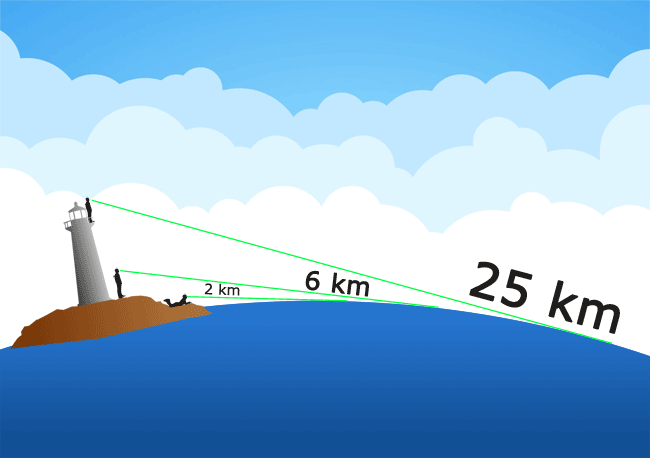 R:
Here is a table containing different heights in relation to sea level, to give you an idea:
R:
Here is a table containing different heights in relation to sea level, to give you an idea:
| You are lying on the sand and look at the sea at 20 cm from the ground | 1.60 km |
| A standing adult, estimating his eyes at 1.70 m tall | 4,65 km |
| The tallest man in the world, Robert Wadlow 2.72m, estimating his eyes at 2.55m tall | 5.70 km |
| Depuis le pont du navire de Blackbeard, on his frigate the Queen Anne's Revenge, at 6 m high | 8.74 km |
| From the lookout of the frigate Hermione at 50 m high or from the top of a lighthouse. | 25.24 km |
| From the top of the spire of the Notre Dame de Paris cathedral, 96 m high | 34.97 km |
| On top of the Eiffel Tower, 300 m high | 61.83 km |
| On top of the Burj Khalifa Tower to Dubaï, 828 m high / 163 floors | 102.72 km |
| On top of the Mont Blanc, 4 808 m high | 247.54 km |
| On top of the Everest, 8 848 m high | 335.77 km |
| from an aircraft at an altitude of 10,000 m | 356.96 km |
Try the horizon calculator
Enter the height you want in meters, and observe the result.
Formula:where d = distance, R = radius of the earth or 6371.009 km, h = height of the point of view towards the horizon.
We use km for d and R and meters for h, so it must be divided by 1000.
The right questions!
« And if I use binoculars, can I see further? »
Paradoxically, no! This does not change anything because considering an object on the water and because of the curvature of the earth, it is not possible to see behind the horizon. Hence the use of the radius of the earth in the formula.
« What about atmospheric disturbances and other natural elements that interfere with the view? »
Indeed, there are many factors that can vary the distance to the visible horizon, such as:
- the relief of the waves,
- the refraction of the electromagnetic waves according to the nature of the atmosphere, which causes a kind of lifting of the horizon, which moves away the limit. This can reproduce the effect of mirage as if the earth was "less" round.
- the curvature of the earth,
- the temperature,
- thehumidity,
« I read that the earth was not round, so the radius R is not the right one? »
Indeed, the earth is not round, it has rather an elliptic shape, very light of course.
The equatorial radius of the Earth is 6,378.137 km, the polar radius is 6,356.752 km, the radius from the bottom of the Arctic Ocean is 6,352.8 km, the radius from the summit of Chimborazo is 6,384.415 km, the bottom of the Arctic Ocean is a delta of about 32 km.
The formula therefore takes into account the average radius, i.e. 6,371.009 km, which is the unit of length used in fields such as astronomy and geology.
Question of Marc (01.30.2023): How many grains of sand are there on earth?
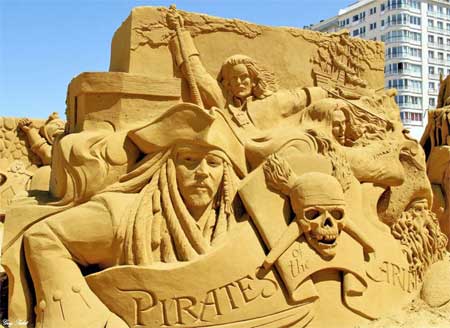 R:
7.5 trillion grains of sand on Earth, can you believe it?
R:
7.5 trillion grains of sand on Earth, can you believe it?
That's the incredible discovery of Professor Howard C. McAllister of the University of Hawaii. He established this number by using a complex mathematical formula based on kilometers of shoreline, beach depths and average sand grain size.
But Eric Chaumillon, a researcher at the University of La Rochelle, has a different estimate - 200 billion billion billion grains of sand.
How exactly did they make their calculation?
- The first started from the principle that there were 200,000 km of shoreline in the world and that a quarter of them were covered with sand, that the beaches were on average 30 meters long and 5 meters deep, based on a volume of 1mm3 occupied for 1 grain of sand. That is 7 500 000 000 000 000 000 grains of sand (7.5 x 10^18)
- The second one is based on the total volume of sand representing 1% of the Earth's crust, which is itself 1% of the volume of the Earth. That is 200 000 000 000 000 000 000 000 000 grains of sand (2 x 10^26).
This second calculation is also true because the first one does not take into account deserts such as the Sahara. The latter is the largest non-polar desert in the world and covers more than 9,000,000 km² of North Africa, but most of its surface is a hamada or rocky plateau. The dune fields of the Sahara cover only about 15% of the total desert surface...
What is the real number? That's for you to decide. The world is full of fascinating mathematical puzzles that leave us speechless.
Question of Al (01.18.2023): What are the figures for maritime piracy in the world today?
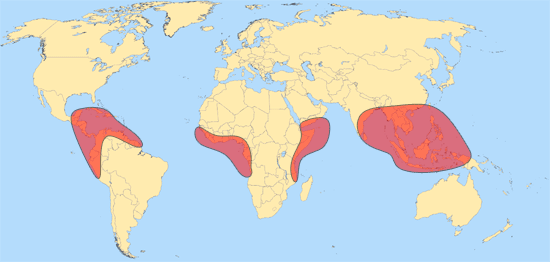 R:
Since 1990, more than 7,000 acts of piracy have been recorded worldwide.
R:
Since 1990, more than 7,000 acts of piracy have been recorded worldwide.The economic costs of these acts are estimated at between 7 and 12 billion dollars per year. Until 2016, pirates operating off the coast of Somalia were considered responsible for 95% of these global costs.
Below, the acts of maritime piracy in figures (which are regularly updated over the years):
| Year | Number of attacks |
| 2022 | 115 |
| 2021 | 132 |
| 2020 | 195 |
| 2019 | 162 |
| 2018 | 201 |
| 2017 | 180 |
| 2016 | 191 |
| 2015 | 246 |
| 2014 | 245 |
| 2013 | 264 |
| 2012 | 297 |
| 2011 | 439 |
| 2010 | 445 |
| 2009 | 406 |
| 2008 | 293 |
| 2007 | 263 |
| 2006 | 239 |
| 2005 | 276 |
| 2004 | 325 |
| 2003 | 445 |
| 2002 | 370 |
| 2001 | 335 |
| 2000 | 337 |
| 1999 | 309 |
| 1998 | 202 |
» See the map showing the maritime piracy acts in real time
In 2005, the average ransom paid to pirates was $150,000. However, in 2010, this amount increased dramatically to more than $5 million, with a record $9.5 million paid in November 2010 for the release of a South Korean oil tanker.
To combat piracy at sea, a new law has been put in place. It allows French courts to judge the pirates, rather than third countries. French courts now have jurisdiction over acts of piracy committed outside of France, regardless of the nationality of the ship or the victims, when the pirates are apprehended by French agents.
In addition, a European anti-piracy force (Atalanta) has been deployed since 2008 in the Indian Ocean to reinforce maritime security.
Maritime piracy in 2015
Criminal activity related to piracy varies by geographic area. Southeast Asia is particularly affected, with "very high risk areas" such as the Strait of Malacca, western Peninsular Malaysia and the waters between the Philippines and the Malaysian state of Sabah. The "risk areas" for the region also include the Gulf of Thailand and the waters around Vietnam, the Philippines and northern Borneo.Somali piracy is down significantly, with no incidents reported in the first nine months of 2015. However, the Marshall Islands were particularly affected, with 40 acts of piracy committed against vessels of their companies.
Maritime piracy in 2017
Piracy is down worldwide, with the exception of the Nigeria region. There has been a sudden increase in attacks at sea in the Horn of Africa, where piracy seems to have moved to the Gulf of Guinea, an area rich in oil fields. Most of the pirates are Nigerian nationals hiding in the mangroves of the Niger Delta. It should be noted that for the first time in 25 years, Somalia no longer appears on the piracy statistics.Maritime piracy in 2018
Piracy is on the rise with a total of 201 recorded acts. There are two countries that concentrate the majority of these acts: Nigeria with 48 cases and Indonesia with 36. All other countries have a much lower number of incidents, not exceeding 12.As for the continents, East Asia records 7 acts, India 18, America 29, Southeast Asia 60 and Africa 87.
Maritime piracy in 2019
There were 3 times fewer acts of piracy than in 2003 and 2010 (445 incidents), according to the annual report of the International Maritime Bureau (IMB). The incidents are broken down as follows: 11 shots fired at ships, 17 unsuccessful attack attempts, 130 collisions and 4 ship hijackings.However, a disturbing trend is revealed by the ICC, a significant increase in kidnappings, from 83 in 2018 to 134 in 2019, an increase of 61%. The Gulf of Guinea accounts for more than 90% of kidnappings (121 kidnappings, an increase of 55%).
Maritime Piracy in 2020
The Covid-19 pandemic has unfortunately led to an increase in acts of piracy, reaching a total of 375. The Gulf of Guinea, considered the most dangerous region in the world, continues to see an increase in violent incidents and kidnappings. Pirate areas of operation have expanded from the coast of Ghana to Equatorial Guinea. In the Indian Ocean, the number of incidents remains low, but there has been an increase in thefts at anchor in the Bay of Bengal. In Southeast Asia, the Straits of Malacca and Singapore continue to be the most affected areas for robbery. In Latin America, robberies in major commercial ports are common, while boaters are targeted by thieves operating throughout the Caribbean arc.Maritime piracy in 2021
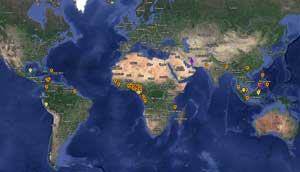 Maritime piracy in the world in 2021In 2021, Bureau Maritime International (BMI) counted 132 acts of piracy on the seas of the world, the lowest since 1994. However, in the Singapore Strait, they have increased by 50%. These incidents include 115 vessels boarded, 11 attempted attacks, five vessels fired upon and one vessel hijacked.
Maritime piracy in the world in 2021In 2021, Bureau Maritime International (BMI) counted 132 acts of piracy on the seas of the world, the lowest since 1994. However, in the Singapore Strait, they have increased by 50%. These incidents include 115 vessels boarded, 11 attempted attacks, five vessels fired upon and one vessel hijacked.
Maritime piracy in 2022
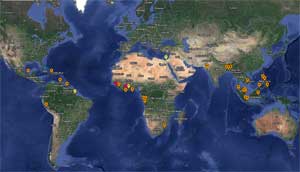 In 2022, there were 115 acts of piracy against ships, a 13 percent decrease from the previous year. This figure is the lowest in over three decades. The International Maritime Bureau (IMB) reported that half of these incidents took place in Southeast Asian waters, including the Singapore Straits, an area particularly affected by piracy.
Although the figures show a significant decrease in piracy, they actually mask a "shift" to criminal activities considered more profitable and less risky.
In 2022, there were 115 acts of piracy against ships, a 13 percent decrease from the previous year. This figure is the lowest in over three decades. The International Maritime Bureau (IMB) reported that half of these incidents took place in Southeast Asian waters, including the Singapore Straits, an area particularly affected by piracy.
Although the figures show a significant decrease in piracy, they actually mask a "shift" to criminal activities considered more profitable and less risky.
© Photos: ICC Commercial Crime Services
Question of Marcus (01.07.2023): Which pirates have made the most catches?
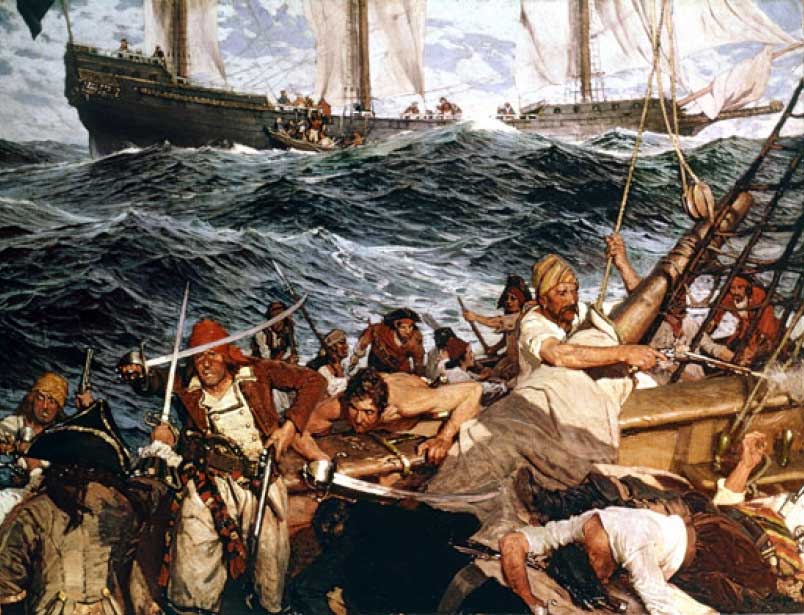 A:
It was between 1716 and 1726 that pirates captured the most ships, and did much more damage to trade than the naval campaigns of the empires and privateers during the War of the Spanish Succession (1701-1713). This is an extraordinary statement made by Captain Johnson - who is actually Daniel Defoe, or Nathaniel Mist according to some, the reality remains to be proven, but that's another story.
A:
It was between 1716 and 1726 that pirates captured the most ships, and did much more damage to trade than the naval campaigns of the empires and privateers during the War of the Spanish Succession (1701-1713). This is an extraordinary statement made by Captain Johnson - who is actually Daniel Defoe, or Nathaniel Mist according to some, the reality remains to be proven, but that's another story.
The prize for the greatest number of catches made by pirates*
- The trophy goes unquestionably to the pirate Bartholomew Roberts who captured and pillaged more than 400 ships between 1719 and 1722.
- In second place was the pirate Edward Low, who captured nearly 140 ships.
- The terrifying Edward Teach, also known as Blackbeard, captured almost as many between the end of 1716 and the end of 1718.
- Captain Sam Bellamy and his fellow pirates captured more than 50.
- Next came Edward England and Charles Vane with 50 each.
- Then Charles Harris with 45.
- Francis Spriggs: 40.
- James Philips: 34.
- George Lowther: 33.
- Richard Holland: 25.
If we estimate that the 70 other pirate captains listed seized an average of 20 ships each, we obtain a total of more than 2,400 ships captured and pillaged**.
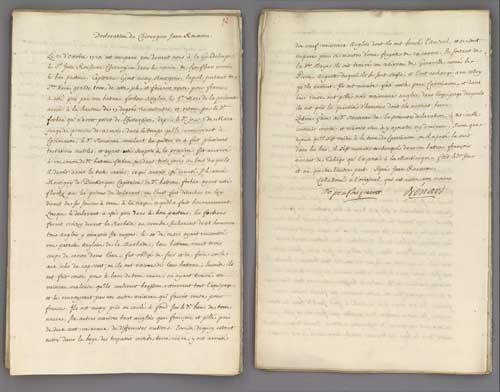 However, the count may be underestimated, because according to the declaration of a surgeon captured by Captain Montigny of Dunkirk, more than 200 ships were pillaged. He is therefore second in the list***.
However, the count may be underestimated, because according to the declaration of a surgeon captured by Captain Montigny of Dunkirk, more than 200 ships were pillaged. He is therefore second in the list***.<== See the statement opposite, at the bottom of the 1st page.
It is important to note that many pirate captains were sometimes magnanimous and would return the catch to the victims, provided they did not make too much of a fuss and were from a nation that the pirates did not hate.
Pirates had little means of reselling large goods such as sugar, tobacco, or spices, and preferred to take only a little booty, food, drink, and medicine.
During this golden age of piracy, there was a real crisis in maritime trade, so much so that rival empires were forced to cooperate. In 1721, the British and French governments in the Caribbean concluded an agreement for joint protection.
The biggest catch ever made
The biggest catch ever made was undoubtedly that made by the French pirate Olivier Levasseur, known as La Buse, and Taylor who captured La Vierge du Cap (the Virgin of the Cape / Nossa Senhora do Cabo), a flagship of the Portuguese Navy of 800 tons and 72 cannons. The ship was carrying the Viceroy of the Portuguese East Indies and the Archbishop of Goa. The immense treasure contained rivers of diamonds, jewels, pearls, gold and silver bars, furniture, cloth, sacred vessels and other precious objects of worship, a treasure that historians estimate at 5 billion euros. This capture is undoubtedly the largest in the history of piracy.Sources :
* : Between the Devil and the Deep Blue Sea: Merchant Seamen, Pirates and the Anglo-American Maritime World, 1700-1750 - Markus Rediker
** : History of Pyrates - History Shipping Industry
*** : Declaration made by the surgeon Jean Rousseau, scan francearchives.fr - Pirates day by day - Jean-Pierre Moreau
Question of Theo (09.03.2022): What is the relationship between the Covid- 19 (Coronavirus) and the hackers?
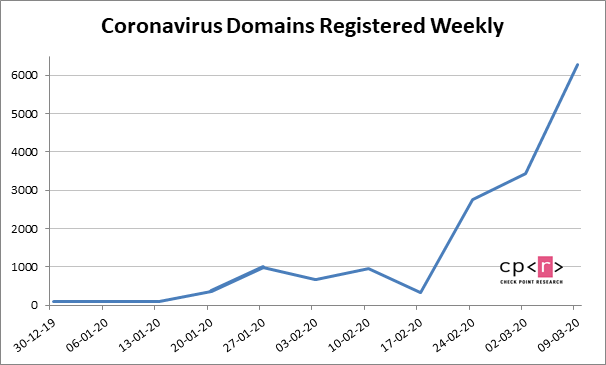 A:
It all depends on whether we are talking about computer hackers or sea pirates.
A:
It all depends on whether we are talking about computer hackers or sea pirates.
In the case of hackers:
Today, hackers around the world are taking advantage of the Covid-19 epidemic to increase their activities and spread their own infections.A lot of hackers are jumping on the wave to create domain names. For example, in January 2020 alone, 16,000 domains related to the coronavirus were created, which is 10 times more than usual. These domain names are intended to sell products, malware and spread false information to people.
Cybercriminals are also taking advantage of the coronavirus pandemic and COVID-19 to attack hospital information systems through fraudulent emails. They have attempted to hijack data from health centers and demanded payment of a Bitcoin ransom.
Some hackers sell Mac computers at very low prices, under the catchphrase "special offer during the coronavirus", while this is obviously false.
Other hackers offer virus tracking cards that are ransomware (example with CovidLock) that prevent users from accessing the contents of their phone. They are forced to pay if they want to unlock it.
There is also a series of emails that offer daily news about the coronavirus. These fake emails provide links to "fake screen" OneDrive or Office365 login. People believe they are on the official pages and enter their credentials and send them to hackers who can use them for dishonest purposes.
The most common fraud is the travel authorization generator created on Tuesday, March 17, 2020. A fake link is circulating on social networks indicating: "you just have to click in order to get a certificate directly on your laptop, for those who don't have a printer. But this link ends with .sh and not .fr! So the site will suck data from your phone.
Fortunately, in all of this, Google claims that it detects some 18 million malware and phishing campaigns related to Covid-19 every day, and that its artificial intelligence manages to block 99.9% of these threats.
In the case of sea pirates
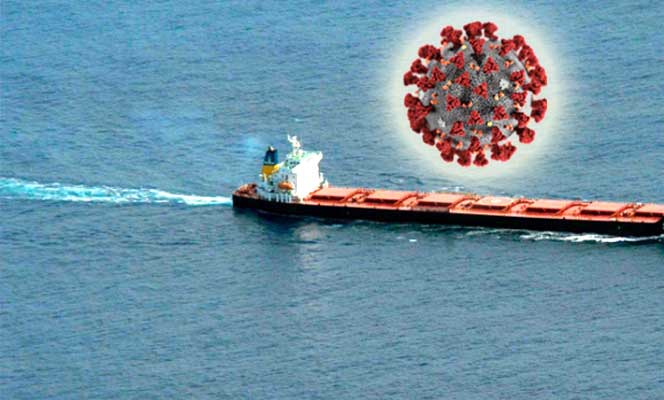 In March 2020, the Tunisian authorities accused Italy of hijacking off the sea, a boat loaded with alcohol for the manufacture of hydroalcoholic gel.
In March 2020, the Tunisian authorities accused Italy of hijacking off the sea, a boat loaded with alcohol for the manufacture of hydroalcoholic gel.«There is a shortage of medical equipment, all states are stealing, it is hysteria, and there are many hijackings at sea. The European Union is no longer what it used to be,» added Trade Minister Mohamed Msellini, when asked about the controversy of the shortage of hydro-alcohol gel.
On the other hand, the Italians accuse the Czech Republic of having done the same with a shipment of 680,000 masks, from a Chinese humanitarian aid to Italy.
As a result, China had to send a new aid package containing 1,000,000 masks on a flight chartered directly to Rome. The city of Prague, capital of the Czech Republic, anxious to prove its good faith, sent 110,000 masks to Italy as compensation.
Soon will come the race for the miracle drug, Chloroquine (or another), discovered by the French professor Didier Raoult, or the race for the vaccine led by the Russians against the Americans... doesn't it remind you of the race to the moon between these two countries in the 60s?
Graph economiematin.fr - photo kapitalis.com - sources sputniknews.com
Question of Lisa (09.02.2022): When did piracy start and when did it end?
 R:
Piracy goes back to the dawn of time, since the day man began to sail about 130,000 years ago, according to archaeological excavations conducted on the island of Crete, not far from Greece.
R:
Piracy goes back to the dawn of time, since the day man began to sail about 130,000 years ago, according to archaeological excavations conducted on the island of Crete, not far from Greece.And maritime piracy has not ended! It still continues today and with today's technologies.
Piracy has crossed all ages:
- prehistory, homo-sapiens (~120 000 BC - ~3500 BC),
- the Antiquity (52 BC-476),
- the Middle Ages (476-1492),
- the renaissance (1492-1610),
Then the modern era including:
- the English Sea Dogs and Dutch privateers (1610-1650),
- the Buccaneers (1650-1690),
- the golden age of piracy (1690-1730),
- the decline of piracy (1730-1900),
And finally:
- The Contemporary Era (1900 to present)
© Oil painting "The Buccaneers" by Frederick Judd Waugh
Question of Julie (08.30.2022): What are the most famous pirate ship names?
R: Many pirate ships are famous, not only for the fame of their captains, but also for the feats they performed and the discovery of their wrecks centuries later.
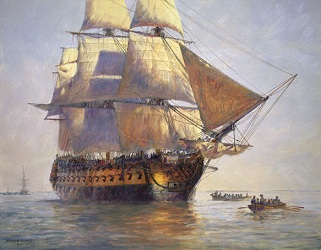
Queen Anne's Revenge
Frigate of the pirate Blackbeard (Blackbeard en français, supposedly named Edward Drummond). This 300-ton, 26-gun ship, built in 1710, was engaged in the slave trade and owned by the Frenchman René Montaudouin and was called "Le Concorde". Blackbeard seized it on 28 November 1717. It was sunk in May 1718 off Beaufort, North Carolina and was recovered in 1996.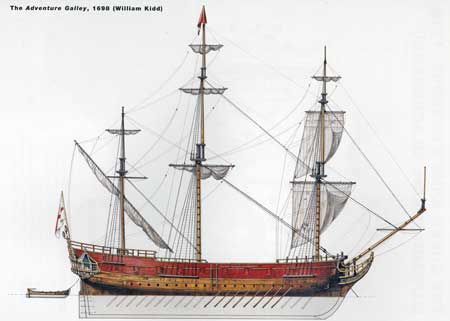
Adventure Galley
An English ship of the pirate William Kidd (or Captain Kidd) in 1698, armed with 36 guns and a crew of 70 men.It was a hybrid ship, combining square-rigged sails and oars to give it manoeuvrability in both wind and calm.
The ship was bought for £8,000, or £970,000 today, equivalent to about €1.2 million. She could reach 14 knots (26 km/h) under full sail.
By 1698, the ship's hull had become so rotten that it was no longer seaworthy. She was stripped of everything movable and sunk off the northeast coast of Madagascar according to Captain Kidd, but was reportedly washed ashore in Madagascar according to William Jenkins, one of Captain Kidd's crew. Her remains have not yet been found.
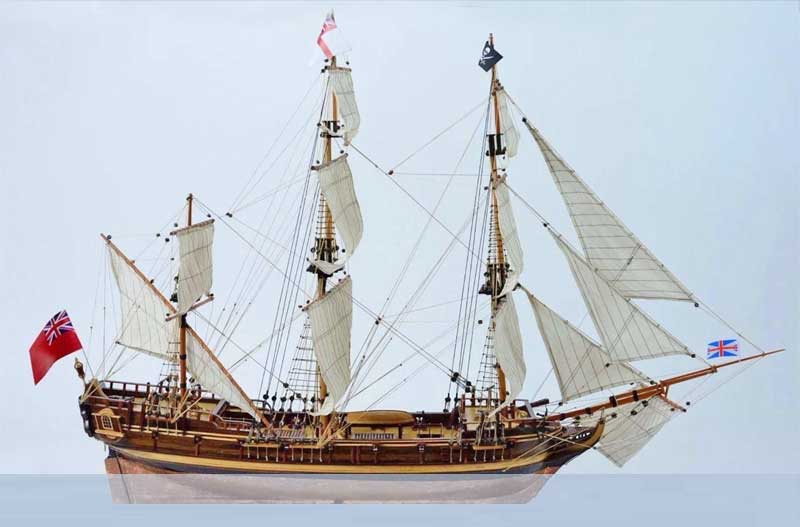
Whydah Gally
Ship of the pirate Samuel « Black Sam » Bellamy. It sank in a storm off Cape Cod on 26 April 1717 with its captain and almost the entire crew. The wreck was recovered in 1996 and contained many riches.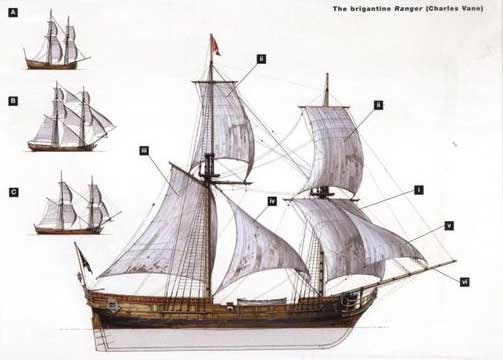
The Ranger
Brigantine of 12 guns and 80 men belonging to the pirate Charles Vane.
Royal James
Sloop of the pirate Stede Bonnet in 1718. Unusually, it was Bonnet himself who bought the 10-gun ship, which he named The Revenge. Later, in order to escape the King's pardon and the resumption of his piracy activities, he renamed his ship The Royal James, probably in honour of the Knight of St. George, the son of the banished English king, James II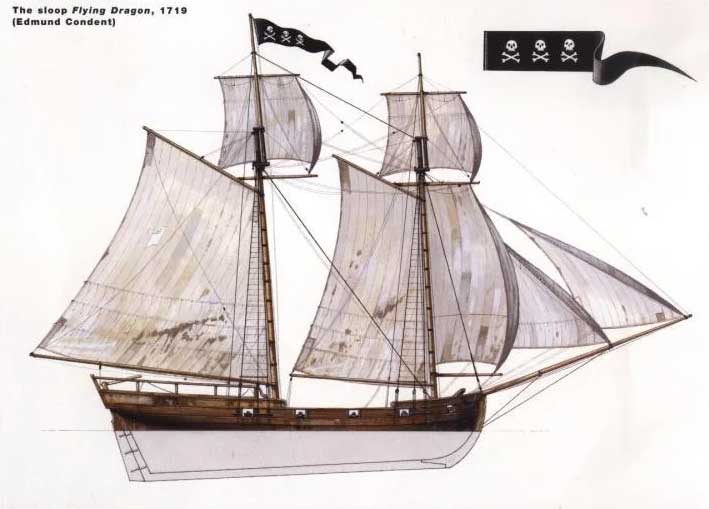
Flying dragon (le Dragon Volant)
Sloop of the pirate Edmund Condent in 1719. He captured this Dutch-origin ship in the Cape Verde Islands.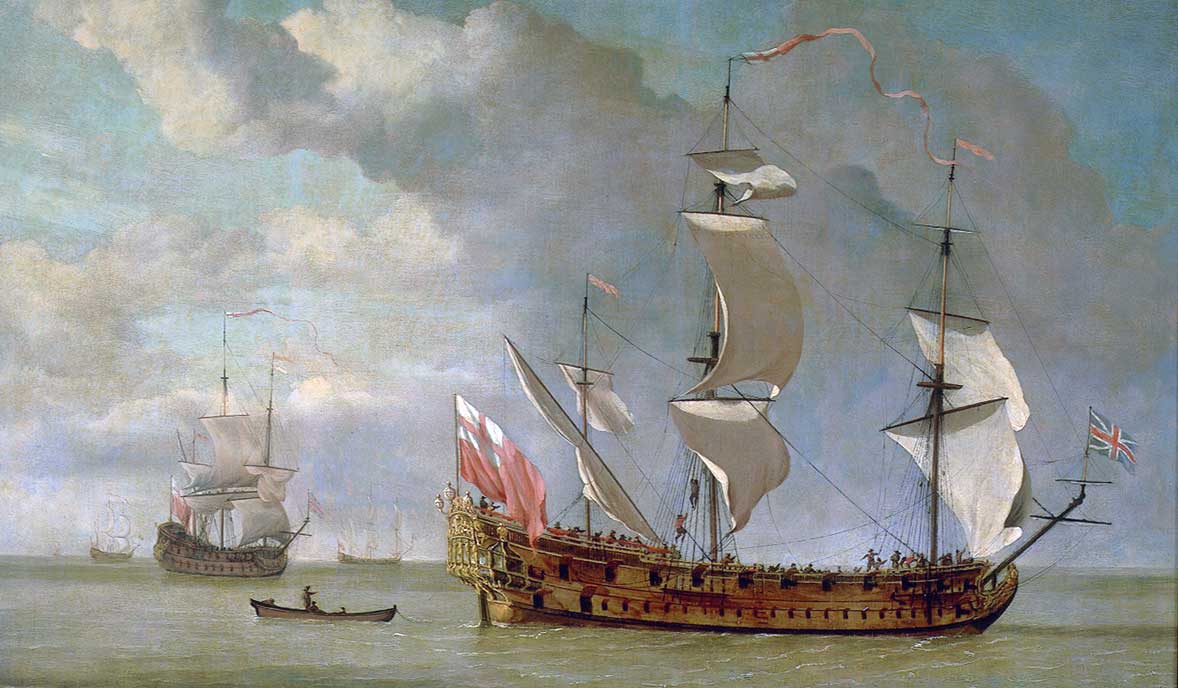
Fancy
Ship of the pirate Henry Every known as Long Ben between May 1694 and late 1695.The Fancy was a 46-gun frigate originally named Charles II, in the service of Spain, previously commanded by Captain Gibson.
Henry Every had the Fancy refitted in the Comoros Islands, intentionally removing parts of the ship's superstructure to increase her speed. As a result of this work, the Fancy became one of the fastest ships in the Indian Ocean.
Although the fate of the Fancy is unknown, it is rumoured that Every gave it to the Governor of Nassau as a bribe. There is documentary evidence that the Fancy ran aground in New Providence and that Governor Trott had the cannons and anything else of value stripped off.
The painting on the right is the ship The Charles Galley, which is a very similar ship to The Fancy.
Oxford
Ship of the English buccaneer Henry Morgan in 1669.This ship was ordered from the Deptford Dockyard on 28 December 1654 and delivered in November 1656. The shipowner was Manley Callis who served from 1634 to 1657. The Oxford was armed with 18 guns and passed through the hands of ten captains in the 13 years of her existence.
The wreck was discovered in 1980 by Erick Surcouf (descendant of the famous privateer Robert Surcouf).
La Vierge du Cap (The Virgin of the Cape) renamed as Le Victorieux (The Victorious)
Ship of the pirate Olivier Levasseur, known as La Buse, which he refitted in April 1721 and renamed Le Victorieux. This 72-gun ship originally belonged to the Portuguese and carried the vice king of the East Indies and the archbishop of Goa.Royal Fortune
Sloop of the pirate Bartholomew Roberts (Black Bart or Black baronet) in 1722.Fancy
Dutch 34-gun ship of the pirate Edward England in 1720.The William
Sloop of the pirates Calico Jack (Jack Rackham) and Ann Bonny in 1720.You can see the Queen Anne's Revenge and the Whydah Gally in the video below, which shows the differences in size of the ships from the 17th century to today.
Question of Nemo (08.27.2022): Why is Return to Monkey Island being released on 19 September instead of Christmas, which would be better commercially?
A:
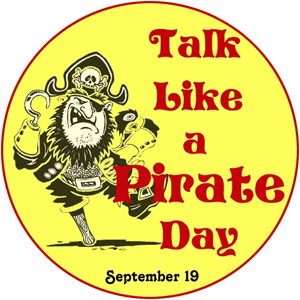 The 19 September is a strategic and well-considered date because the new instalment of Ron Gilbert's famous point-and-click series is being released on International Talk Like A Pirate Day in the USA.
The 19 September is a strategic and well-considered date because the new instalment of Ron Gilbert's famous point-and-click series is being released on International Talk Like A Pirate Day in the USA.An April Fool's Day?
Ron Gilbert, its creator, first promoted his game for this year in what appeared to be an April Fool's joke, but a few days later it turned out that he wasn't really joking. The new game is a direct sequel to The Secret of Monkey Island and Monkey Island 2 : LeChuck's Revenge.The video trailer for September 19:
Heavyweight studios
Return To Monkey Island, by Ron Gilbert's Terrible Toybox in collaboration with Devolver Digital and Lucasfilm Games.Terrible Toybox has a new and important partner this time: , who co-wrote and co-designed many legendary point-and-click games at LucasArts, including the first two Monkey Island titles.
The game will be available on PC and Nintendo Switch.
Until the game is released
- Enjoy the photo gallery of the famous Monkey Island saga and the original paintings, fan art and concept art (in the french website)
- The official website returntomonkeyisland.com

Question of Pauline (04.21.2016): Can you give me the name of two famous St. Malo corsairs? Thank you in advance!
A: The two most famous are:
 - Duguay-Trouin whose real name was René Trouin du Gué (June 10, 1673 Saint-Malo - September 27, 1736 Paris)
- Duguay-Trouin whose real name was René Trouin du Gué (June 10, 1673 Saint-Malo - September 27, 1736 Paris) Robert Surcouf (December 12, 1773 Saint-Malo - July 8, 1827).
Robert Surcouf (December 12, 1773 Saint-Malo - July 8, 1827).
Question of Lord Nelson (04.20.2016): How to keep the sails on the masts?
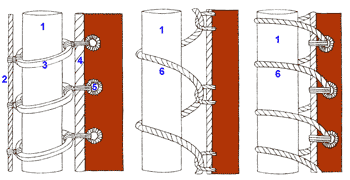 A:
On many types of ships sails are adjusted to the yards, which are pieces of wood placed across the mast.
A:
On many types of ships sails are adjusted to the yards, which are pieces of wood placed across the mast.The exception to this is the Bermuda sail, the mainsail and sail sprit that are attached to the mast.
(Fasteners sails). In all three cases if one goes into detail, the sail is attached via rocambeau rings (3) (or rings of sizes according to the sails) that are stacked on the mast (1), or the mast rope (6) is wound in a spiral around the mast.
Halyard (2) is used for hoisting the sail down the mast, also raises the veil enhanced by its rope (4) sewn on its sides, and is attached by its Eyes-coats (5).
© Photo Boats, Gründ editions
Question of Maureen - Nyn B. (04.19.2016): I'm a writer and I would like to know whether there are very specific first names of pirates or there are some that would be better. And the last names? Thank you for your cooperation!
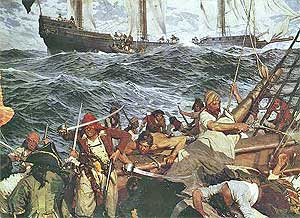 A:
You can see the names of the crew of Blackbeard a.k.a. Edward Teach (or Drummond) at this link.
A:
You can see the names of the crew of Blackbeard a.k.a. Edward Teach (or Drummond) at this link.Here is in particular the list of the crew of Edward Low.
The full names are more mundane. But bear in mind that many pirates preferred to use nicknames. These nicknames were not all wacky, like Blackbeard (Edward Teach), the Exterminator (Monbars), La Buse (Olivier Levasseur), Calico Jack (John Rackham), etc ... there were some common names invented to leave no trace of their past, because they were often thieves, former Royal Navy (which inflicted harsher punishments than its soldiers did as pirate captains) and other criminals.
© Painting: Frederick Judd Waugh "The Buccaneers"
Question of Tristan (04.18.2016): I’d like to have a timeline of the conquest of Puerto Bello made by Henry Morgan in 1668, as well as other information such as the number of boats, men, dead, etc. Thank you.
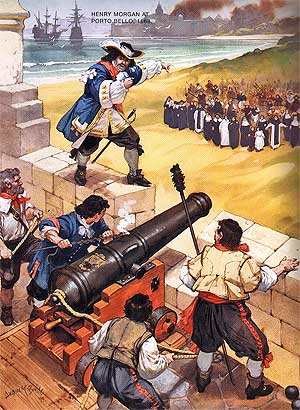 A:
After looting Puerto Principe and that taking bringing only 60 crowns to each man, Henry Morgan suggested capturing Porto Bello in 1668, mistress city to boarding coveted metal from Peru: gold.
A:
After looting Puerto Principe and that taking bringing only 60 crowns to each man, Henry Morgan suggested capturing Porto Bello in 1668, mistress city to boarding coveted metal from Peru: gold.No one has ever managed to seize the city. Several British died in the storming as did Sir Francis Drake.
60 cannons were directed to the entrance of the bay to repel all intruders. The attack of Porto Bello by sea was suicidal.
Morgan decided to weigh anchor with its fleet of eight small vessels. He met an adventurer from Campeche taking part in the project. Morgan lead nine vessels and 470 men.
He landed at Naos, a village 12 miles from the goal he would not forget to loot. From there he sailed along the coast to the port of El Puerto del Ponton, 4 miles from Porto Bello.
After 4 days, shortly after midnight, he reached the first peak of the town of Porto Bello. He built pretty high and wide wooden ladders that three men could climb head on. The operation was difficult and he lost many men. He ordered a group to go into convents and bring monks and nuns. His men pointed their weapons towards the religious order and carried ladders to the speakers of the fort.
They climbed and Spanish defenders of the fort lifted their arms because they believed that they would go to hell if they killed a religious person. They were caught by the pirates climbing behind the religious people. The fort would have been blasted to let in Morgan's army.
Alexandre-Olivier OExmelin (or OExquemelin) described him as a rapist and a robber. The fort was never destroyed because it was still standing. Morgan was furious to read these lies in the stories of the writer OExmelin.
Morgan used this first fort there to store his injuries.
He used guns to attack the second fort hard and conquered it with much more ease.
The third fort held strong for a little longer, and the fight was finished around 3 in the afternoon. Morgan was the winner.
Joseph brought his ships to port the next morning while his adventurers looted the city.
He returned to Jamaica with over 260,000 crowns and jewels, as well as fabrics and many valuable goods.
To summarize in numbers:
- Henry Morgan had 9 small vessels including 470 men,
- The fort of Porto Bello was composed of 400 Spanish soldiers
- 260,000 crowns and jewels and many other goods were looted.
» Porto Bello Google Maps (Detailed)
» Porto Bello Google Maps (large scale)
© illustration by Angus McBride and Osprey Publishing, from the book Buccaneers 1620-1700, Osprey Publishing
Question of Anonymous (04.18.2016): Were there ships carrying 100 guns? Are there any bigger ships as frigates?
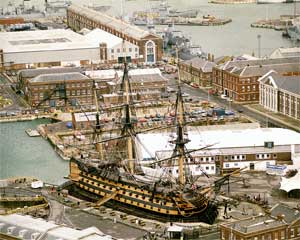 A:
(Ships with more than 100 guns)
There are indeed vessels of more than 100 guns called three-decker ships with 120 guns, built in the 1800s, such as H.M.S. Victory for example.
A:
(Ships with more than 100 guns)
There are indeed vessels of more than 100 guns called three-decker ships with 120 guns, built in the 1800s, such as H.M.S. Victory for example.There were all kinds of guns on board, guns 12, 24, 32 pounds and pivots cannons.
- More info about guns.
Question of Anonymous (04.15.2016): How old was Blackbeard when he died?
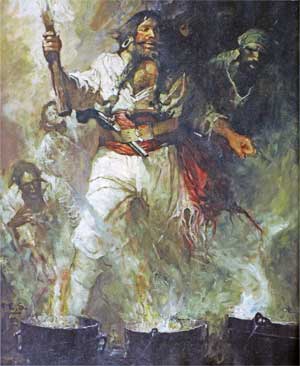 A:
Blackbeard would have been about 38 years old when he died; his exact birth date is unknown, but it is around 1680.
A:
Blackbeard would have been about 38 years old when he died; his exact birth date is unknown, but it is around 1680.He died on November 22, 1718 in a violent struggle against Lieutenant Maynard of the Royal Navy.
© Blackbeard in smoke and flames, painting by Frank E. Schoonover - 1922
Question of Levasseur, Barbossa & tiny corsair (04.14.2016): For some time I've been wanting to know what makes the rudder turn. Can you help me?
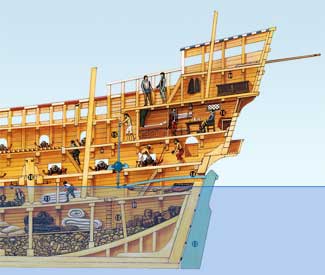 A:
An example of rudder on a galleon dating back to the seventeenth century.
We can see in blue the whole mechanism articulating the helm.
A:
An example of rudder on a galleon dating back to the seventeenth century.
We can see in blue the whole mechanism articulating the helm.The control bar or manual (figure 15) is operated by a man holding the position of helmsman.
Between 14 and 15 the "ball" is called pintle.
The movement of the rod actuates the drawbar (14), which in turn rotates the rudder on its hinges (13).
We can see that the helmsman directing the rudder was inside the ship and could not see where he was heading. He followed the rudder maneuver orders of a second captain who was on the quarterdeck of the ship.
The wheel was created in the early eighteenth century.
© Illustration by Grisewood & Dempsey Ltd, London
Question of Nathan (04.14.2016): Could you display a picture of a flintlock pistol?
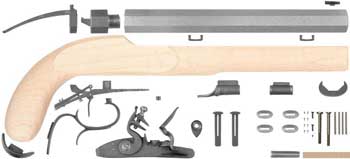 A:
Here is a picture of a dismantled flint gun.
A:
Here is a picture of a dismantled flint gun.
© source: www.trackofthewolf.com
» see integrality of questions/answers (total: 126) |







 French version -
French version -